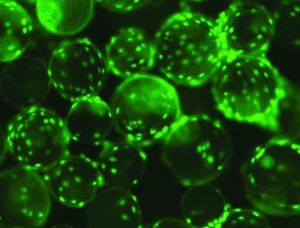
Human mesenchymal stem cells (hMSCs) on Corning Synthemax II polystyrene microcarriers (WWW.CORNING.COM)
Three-dimensional (3D) bioprinting is the newest addition to the regenerative medicine family. Now within the industry dedicated to providing more personalized drug products, this new additive-manufacturing technology has the potential to truly focus on individual tissue repair and replacement. In a short period of time, 3D bioprinting has been applied in studies using bones, blood vessels, composite tissues, vascular grafts, tracheal splints, cartilaginous structures, heart tissue (e.g., two-valve heart), and vaginal organs (1).
View the full article below – Login Required
Please log in to access this content.
References
1 Yoo J. Current Developments and Clinical Perspectives of Bioprinting Technology. Biotech Week Boston: 7 October 2016.
2 Szczerba RJ. No Donor Required: 5 Body Parts You Can Make With 3-D Printers. Forbes 17 June 2015.
3 Chartrain N, Williams CB, Whittington AR. Engineering Tissues with Bioprinting. BioProcess Int. 14(10) 2016: 28–33.
4 Wang M, et al. The Trend Towards In Vivo Bioprinting. ResearchGate July 2015; doi: 10.18063/IJB.2015.01.001.
5 Chung J. Bio-Ink Properties and Printability for Extrusion Printing. Liv. Cells. Biomater. Sci. 1, 2013: 763–773; doi: 10.1039/C3BM00012E.
6 Nishiyama Y, et al. Ink Jet Three-Dimensional Digital Fabrication for Biological Tissue Manufacturing: Analysis of Alginate Microgel Beads Produced by Ink Jet Droplets for Three Dimensional Tissue Fabrication. J. Imaging Sci. Technol. 52(6) 2008.
7 Ozbolat IT. Scaffold-Based or Scaffold-Free Bioprinting: Competing or Complementing Approaches? J. Nanotechnol. Eng. Med. 6 2015; doi: 0.1115/1.4030414.
8 Norotte C, et al. Scaffold-Free Vascular Tissue Engineering Using Bioprinting. Biomaterials 30(30) 2009: 5910–5917; doi: 10.1016/j.biomaterials.2009.06.034.
9 Mironov V, Kasyanov V, Markwald RR. Organ Printing: From Bioprinter to Organ Biofabrication Line. Curr. Op. Biotechnol. 22(5) 2011: 667–673.
10 Miller JS. The Billion Cell Construct: Will ThreeDimensional Printing Get Us There? PLOS Biology June 2017; http://journals.plos.org/plosbiology/article?id=10.1371/journal. pbio.1001882.
11 Organovo’s Bioprinting Platform: Enabling 3D, Architecturally Correct, Fully Human Tissue for Drug Discovery and Transplantation. Cell and Gene Meeting: La Jolla, CA, October 2016.
12 Kolesky D. Biotech Week Boston: 4–7 October 2016.
13 Homan KA, et al. Bioprinting of 3D Convoluted Renal Proximal Tubules on Perfusable Chips. Sci. Rep. 11(6) 2016: 34845. doi: 10.1038/srep34845.
14 Yu Y, Zhang, Y, Ozbolat IT. Evaluation of Cell Viability and Functionality in Vessel-Like Bioprintable CellLaden Tubular Channels. J. Biomech. Eng. 135(9) 2013; doi:10.1115/1.4024575.
15 Kolesky D, et al. 3D Bioprinting of Vascularized, Heterogeneous Cell-Laden Tissue Constructs. Adv. Materials 26(19) 2014: 3124–3130; doi: 10.1002/adma.201305506.
16 Lee VK, et al. Creating Perfused Functional Vascular Channels Using 3D Bioprinting Technology. Biomaterials 35(28) 2014: 8092–8102.
17 Grigoryan B, Miller J. The Ambitious Future of Tissue Engineering. Democratizing Cell Technologies 3 January 2017. http://roosterbio.blogspot.com.
18 Squillaro T, Peluso G, Galderisi U. Clinical Trials with Mesenchymal Stem Cells: An Update. Cell Transplant. 25(5) 2016: 829–848.
19 Nguyen DG. Bioprinted 3D Primary Liver Tissues Allow Assessment of Organ-Level Response to Clinical Drug Induced Toxicity In Vitro. PLOS One 7 July 2016; http://dx. doi.org/10.1371/journal.pone.015867.
Maribel Rios is managing editor of BioProcess International; mrios@bioprocessintl.com.
